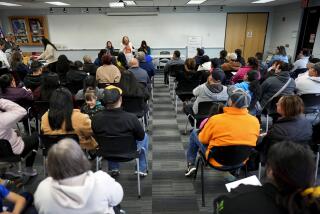Project Aims to Reclaim a Patch of Prairie
- Share via
PRAIRIE CITY, Iowa — Where Pauline Drobney stands, which at the moment happens to be amid acres of windswept grasses and wildflowers, America’s tall-grass prairie seems to be alive and thriving.
At the Neal Smith National Wildlife Refuge, where Drobney works, big bluestem, spiderwort, purple coneflower and ragweed wave in the breeze, extending hundreds of yards in every direction.
But Drobney knows this prairie is an exception, not the rule.
“In Iowa, 99.9% of the historic natural landscape is gone. Arguably it’s the most of any state in the union, the most decimated ecologically,” said Drobney, a biologist at the refuge.
“This was a stronghold for the tall-grass prairie--30 million acres just in Iowa. This was the state that had the largest percentage of its area covered by tall-grass prairie.”
Since 1992, Drobney and other U.S. Fish and Wildlife Service employees have worked with volunteers at the refuge to revive plants, insects, birds and animals that thrived on Iowa’s southern plains centuries ago, before the farms and cities.
The refuge is located on the outskirts of--where else?--Prairie City, about 20 miles east of Des Moines.
The Fish and Wildlife Service now owns more than 5,000 acres of an 8,600-acre zone tapped for eventual acquisition. Much of the land was intended for a nuclear power plant, but when plans for the plant were scrapped, then-Rep. Neal Smith (D-Iowa) lobbied Congress in 1990 to reestablish the prairie at the site.
Smith lost his reelection bid to Congress in 1994, and the refuge--then called Walnut Creek National Wildlife Refuge--was later renamed in his honor.
Drobney and the refuge staff are trying to re-create what the prairie looked like in the 1840s because those are the earliest, most complete written records.
“They’re writing the book on this,” said Mark Ackelson, president of the Iowa Natural Heritage Foundation, a Des Moines-based nonprofit group working to protect Iowa’s natural resources.
“There has been a lot of reconstruction going on, but nothing to this scale. Not only not to this scale, but their attention to details and authenticity has made it head and shoulders above the rest,” Ackelson said.
He said the refuge has brought many people into prairie restoration, involving them in the interactive Prairie Learning Center and recruiting volunteers to collect and plant seeds.
The refuge also has an oak savanna restoration project. In one savanna area, Drobney has conducted prescribed burns for two seasons to rid the landscape of nonnative plants.
A short walking trail winds through that savanna.
“What we’re hoping to do here is find ways that people can touch,” Drobney said. “If you don’t touch something, you don’t really own it, and you can’t preserve something if you don’t even know it exists. So here’s a way.”
Future plantings are now seedlings in a small greenhouse at the refuge. Drobney walks among thousands of green sprouts, pulling out an occasional weed and pointing out where seeds came from. Most are from other small patches of native prairie around Iowa.
The goal is to get different sources for seeds to expand the genetic pool for each species.
Drobney describes her work as prairie emulation, not re-creation. Things will never be as they once were, she said. Some native species are extinct. The refuge has no control over headwaters that bring nitrates and pesticides into its water.
“There are some limitations that we’ll never be able to completely reckon with,” she said. “Passenger pigeons are extinct. The soil that once occupied the uplands has been washed away. We can’t put that soil back.”
It’s a common misconception that prairie restoration projects simply mean letting plants grow wild. Drobney laughed at the suggestion and outlined a complex schedule of seed plantings, controlled burns and species reintroductions.
One of the refuge’s biggest attractions is its herd of buffalo, which started with eight buffalo brought here in October 1996 and has grown to about 50. Elk were introduced in 1998.
Prairie chickens, though, will have to wait.
“This is something that we want back, but there’s a difficulty in that pheasants compete for nesting space with chickens,” she said. “As our prairie areas develop more thoroughly, my hope and guess is that the pheasants will be on the edges more.”
It’s nothing new for people of the prairie to have a hand in changing how it looks, she said, noting that American Indian tribes once set fires to drive game out of the brush, promote grazing and make travel easier.
Things would have looked far different without those fires.
“The European settlers who came would not have been greeted by open prairies and these open savannas,” she said. “It would have been densely wooded.”
*
Neal Smith National Wildlife Refuge: https://www.fws.gov/r3pao/walnut
Friends of the Prairie Learning Center: https://www.tallgrass.org
Iowa Natural Heritage Foundation: https://www.inhf.org/prairie.HTM
More to Read
Sign up for Essential California
The most important California stories and recommendations in your inbox every morning.
You may occasionally receive promotional content from the Los Angeles Times.













